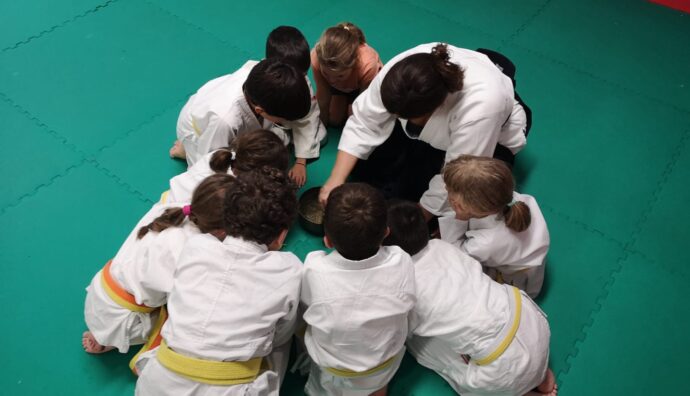In June 2024, Makoto Saito presented a thesis of dissertation at the Japan Advanced Institute of Science and Technology titled “Learning Ecosystems for Club Organizations Promoting Member Retention: Personal Networks in Group Training at an Aikido Dojo – Qualitative and Quantitative Analysis.”
We are always interested in a broad perspective on Aikido and Martial disciplines, and a scientific contribution from Japan certainly deserves some reflection.
From the beginning, the approach and perspective of this paper stand out. The Author makes a clear distinction between institutional training environments (such as companies, universities) and places like Dojos, where the focus is on achieving long-term, lifelong learning.
The Dojo, in this sense, is a place where individuals come together to enrich their lives, unconnected to the economic goals of, for instance, professional training.
While sharing hobbies time and common goals requires minimal organization for practical matters, the practice group is seen as “horizontal“—a group of equals, with little to no hierarchy, except for experience.
Saito highlights the difference between informal meetings with friends who share the same hobby and the Dojo, noting that the latter emphasizes the continuity and organization of activities necessary for an ongoing learning process that aims to “learn while having fun“.
If we reflect about such premises and apply them to our local realities, we could debate for hours. For example, we might consider how the senpai–kohai relationship is a bond of responsibility, not an imposed hierarchy. Or the idea that continuous learning should always involve enjoyment.
But let’s move forward.
The Role of the Learning Ecosystem
In a Dojo, Makoto Saito shows how a “learning ecosystem” develops: a system involving value co-creation, cooperative learning, and collective intelligence. This ecosystem allows Dojo members to improve not only in physical techniques but also in mutual respect and relationship management.
The central element of this ecosystem is freedom of choice. Each practitioner selects their training partner based on personal preferences, and this freedom directly impacts the quality of learning. However, choosing an unsuitable partner can lead to the destruction of co-created value during practice. To avoid this, the Dojo self-regulates through collective intelligence, a shared consciousness among members that implicitly sets the rules for maintaining a positive and collaborative environment.
This raises a question in the context of our local culture: Are partners’ choices truly free during practice? The rush to avoid certain partners or the creation of sub-groups could suggest a need to return to a broader, more inclusive practice.
Value Co-Creation in Aikido
Value co-creation is one of the most significant aspects of Aikido’s learning ecosystem. This concept, borrowed from economic theory, applies perfectly in the Dojo, where value isn’t “consumed” rather continuously created through practitioner interactions. During keiko, the practitioner gains not only physical knowledge and skills but also social and relational abilities. Every exchange with a training partner becomes an opportunity to grow together, strengthening bonds among members and stimulating intrinsic motivation that keeps everyone engaged over time.
Cooperative Learning and Continuity
Cooperative learning is another fundamental pillar. Practice, which in Japan is daily, is structured around the repetition of techniques in pairs, with active and passive roles (nage and uke) that constantly alternate. This system is based on mutual trust and cooperation, creating fertile ground for shared and collective growth.
Saito’s analysis shows that one of the main reasons practitioners continue in the discipline over time is precisely because of this collaborative interaction. Keiko is structured in recurring cycles where each practitioner experiences both the execution and reception of techniques, promoting balanced learning. Regularly changing partners during a practice session allows practitioners to adapt to different approaches (or, in the case of a seminar, styles), skills, and experience levels, making the practice richer and more varied.
Collective Intelligence: Natural Self-Regulation
A unique aspect of Aikido’s learning ecosystem is the concept of collective intelligence. In an environment like the Dojo, interpersonal dynamics are not formalized by rigid rules but emerge naturally. Collective intelligence plays a crucial role in maintaining harmony within the group. Practitioners, consciously or unconsciously, adjust their behaviors according to the group’s needs, supporting cohesion and ensuring that learning remains constructive for everyone.
This self-regulation system reduces interpersonal conflicts, fosters mutual trust, and ensures that even weaker or less experienced members are effectively integrated. Over time, this strengthens the sense of belonging within the group and motivates practitioners to continue their training.
Aikido as a Vehicle for Personal Development
Beyond the technical aspect, Aikido practice fosters the development of cognitive and emotional skills, which can be defined as “somatic knowledge.” This form of knowledge is based on bodily experiences that cannot easily be conveyed verbally but are acquired through action and repetition. The ability to perceive another’s state, respond appropriately to their movements, and synchronize with the flow of their action are all skills developed only through practice.
This process is fundamental to the concept of mastery in Aikido, which does not rely on intellectual knowledge, although this can facilitate understanding certain aspects of the discipline. Instead, mastery comes from the ability to respond spontaneously and with clear intent in real situations, thanks to a deep understanding of one’s body and relational dynamics.
In Conclusion
Aikido represents a unique martial path that, through its learning ecosystem, promotes personal and collective growth. Through a cooperative and self-regulated learning environment, practitioners can improve not only in physical techniques but also in social and relational skills, fostering a lifelong practice.
Value co-creation, collaborative learning, and collective intelligence are the pillars that sustain long-term practice. In an increasingly fragmented world, Aikido offers a model of learning and development that places connection with others, harmony, and mutual respect at the center, making each dojo not just a place for training but an endless learning community.
We are grateful to Makoto Saito, who, with a so important name in the history of Aikido, has offered us a thoughtful perspective on the relational dimension of the Dojo and how it should be structured for a truly enriching practice.

